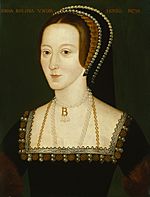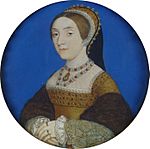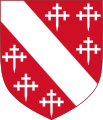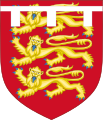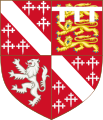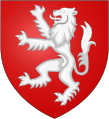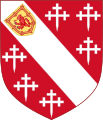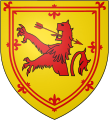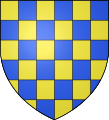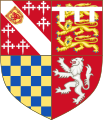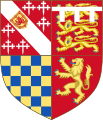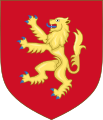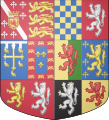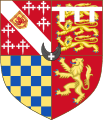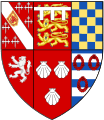Howard family facts for kids
Quick facts for kids Howard family |
|
|---|---|
| Noble family | |
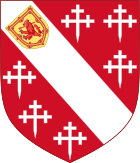 Coat of arms of Howard, granted to Thomas Howard, 2nd Duke of Norfolk |
|
| Country | Kingdom of England, United Kingdom |
| Founded | 1483 |
| Founder | John Howard, 1st Duke of Norfolk |
| Current head | Edward Fitzalan-Howard, 18th Duke of Norfolk |
| Titles |
See list
Extant titles
|
| Estate(s) | |
| Cadet branches |
|
The Howard family is an English noble family founded by John Howard, who was created Duke of Norfolk (third creation) by King Richard III of England in 1483. However, John was also the eldest grandson (although maternal) of the 1st Duke of the first creation. The Howards have been part of the peerage since the 15th century and remain both the Premier Dukes and Earls of the Realm in the Peerage of England, acting as Earl Marshal of England. After the English Reformation, many Howards remained steadfast in their Catholic faith as the most high-profile recusant family; two members, Philip Howard, 13th Earl of Arundel, and William Howard, 1st Viscount Stafford, are regarded as martyrs: a saint and a blessed respectively.
The senior line of the house, as well as holding the title of Duke of Norfolk, is also Earl of Arundel, Earl of Surrey and Earl of Norfolk, as well as holding six baronies. The Arundel title was inherited in 1580, when the Howards became the genealogical successors to the paternally extinct FitzAlans, ancient kin to the House of Stuart, dating back to when the family first arrived in Great Britain from Brittany (see Alan fitz Flaad).
Thomas Howard, 4th Duke of Norfolk, married as his first wife Mary FitzAlan, who, after the death of her brother Henry in 1556, became heiress to the Arundel estates of her father Henry FitzAlan, 12th Earl of Arundel. Her son was the above-mentioned Philip Howard, 13th Earl of Arundel. It is from this marriage that the present Duke of Norfolk takes his surname of FitzAlan-Howard and why his seat is Arundel Castle. There have also been several notable cadet branches; those existing to this day include the Howards of Effingham, Howards of Carlisle, Howards of Suffolk and Howards of Penrith. The former three are earldoms, and the latter a barony.
Throughout much of English and later British history, the Howards have played an important role. Claiming descent from Hereward the Wake, the resister of the Norman conquest who has been much celebrated in folklore, John Howard fought to the death at the Battle of Bosworth Field in defence of the cause for the House of York. The Howards regained favour with the new Tudor dynasty after leading a defence of England from Scottish invasion at the Battle of Flodden, and Catherine Howard subsequently became the fifth wife and Queen consort to King Henry VIII. Her uncle, Thomas Howard, 3rd Duke of Norfolk, played a significant role in Henrician politics. Charles Howard, 1st Earl of Nottingham, served as Lord Admiral of the English fleet which defeated the invading Spanish Armada.
Arundel Castle has been in the family of the Duke of Norfolk for over 400 years, and it is still the principal seat of the Norfolk family. As cultural heritage, it is a Grade I listed building.
Origins
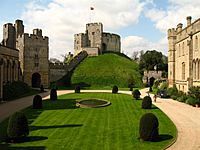
The later Howards would claim legendary descent from Hereward the Wake who was of Mercian background and resisted the Norman conquest of England from his base at the Isle of Ely. Hereward subsequently became a mainstay of English folklore.
A pedigree compiled and signed by Sir William Dugdale, Norroy King of Arms of the College of Arms, and dated 8 April 1665, stated that the Howard family are descended from the Howarth [sic, Howard] family of Great Howarth Hall, Rochdale. Also, "it is clear from above seventy deeds, without date, that the Howards, Dukes of Norfolk, do derive from the Howards Howarth of Great Howarth and that William Howard of Wigenhall… was a direct decedent of Osbert Howard de Howarth," and given lands in Rochdale on behalf of his service as Master of King Henry I's Buckhounds. Dugdale's account, however, has been disputed.
The indisputable descent begins with Sir William Howard (d.1308) of East Winch and Wiggenhall in Norfolk, a Justice of the Court of Common Pleas, who was summoned as a justice to the House of Commons in the Model Parliament of 1295. Sir William's son, Sir John Howard I, became Sheriff of Norfolk and Suffolk and married Joan de Cornwall, an illegitimate granddaughter of Richard, 1st Earl of Cornwall and King of the Romans, the second son of King John.
History
Sir William's great-great-great-grandson, Sir Robert Howard, married Lady Margaret Mowbray, elder daughter of Thomas Mowbray, 1st Duke of Norfolk (1366–1399). The Mowbray line of Dukes died out in 1476 and the heiress of the last Duke, Anne Mowbray, died at the age of nine in 1481; after declaring her widower King Edward IV's son Richard of Shrewsbury, 1st Duke of York, illegitimate, Richard III of England created the son of Sir Robert and Lady Margaret, John Howard, 1st Duke of Norfolk, of a new creation on 28 June 1483, the 200th anniversary of the Barony of Mowbray to which he was also senior co-heir. John had previously been summoned to Parliament as Lord Howard by Edward IV. He was also created hereditary Earl Marshal. John's son and heir, Thomas Howard, 2nd Duke of Norfolk, was the grandfather of two English queens, Anne Boleyn and Catherine Howard, both wives of Henry VIII.
The Howard family became one of the foremost recusant families due to their continued adherence to Roman Catholicism throughout the English Reformation and its aftermath. This meant that they often could not take their seats in the House of Lords. Three family members in a row fell out of favor and were attainted because of their Catholic beliefs: Henry Howard, Earl of Surrey in late 1546 was arrested for treason and also partly for being a Catholic, being executed in January 1547. The son of Surrey, Thomas Howard, 4th Duke of Norfolk who, despite having been brought up as a boy in Protestantism, was a Catholic, fell into disgrace and was executed in July 1572 for having conspired against Queen Elizabeth I with intended to replace her with Mary, Queen of Scots and thus restore Catholicism to England. Norfolk's son, Philip Howard, 13th Earl of Arundel was imprisoned in the Tower of London for his Catholicism in 1585, remaining there for over ten years until he fell ill with Dysentery and he died in October 1595.
Both the Dukedom and Earl Marshalship have been the subject of repeated attainders and restorations in the 15th to 17th centuries. Before Charles II restored the titles for good, the Howards had inherited the ancient title of Earl of Arundel through an heiress, and formed additional branches that have continued to this day.
A branch of the Howard family has been seated at Castle Howard, one of England's most magnificent country houses, for over 300 years.
In order of genealogical seniority:
- the Barons Howard of Penrith descend from a younger brother of the 12th Duke;
- the Earls of Suffolk and Berkshire descend from the 2nd son of the 4th Duke;
- the Earls of Carlisle descend from the third son of the 4th Duke;
- the Earls of Effingham descend from the fourth son of the 2nd Duke, who was Lord High Admiral and whose son was commander in chief against the Spanish Armada. (Curiously, this line was excluded from eligibility to inherit on the restoration of the Dukedom).
Howard family tree
| Earls of Norfolk and Dukes of Norfolk | |||||||||||||||||||||||||||||||||||||||||||||||||||||||||||||||||||||||||||||||||||||||||||||||||||||||||||||||||||||||||||||||||||||||||||||||||||||||||||||||||||||||||||||||||||||||||||||||||||||||||||||||||||||||||||||||||||||||||||||||||||||||||||||||||||||||||||||||||||||||||||||||||||||||||||||||||||||||||||||||||||||||||||||||||||||||||||||||||||||||||||||||||||||||||||||||||||||||||||||||||||||||||||||||||||||||||||||||||||||||||||||||||||||||||||||||||||||||||||||||||||||||||||||||||||||||||||||||||||||||||||||||||||||||||||||||||||||||||||||||||||||||||||||||||||||||||||||||||||||||||||||||||||||||||||||||||||||||||||||||||||||||||||||||||||||||||||||||||||||||||||||||||||||||||||||||||||||||||||||||||||||||||||||||||||||||||||||||||||||||||||||||||||||||||||||||||||||||||||||||||||||||||||||||||||||||||||||||||||||||||||||||||||||||||||||||||||||||||||||||||||||||||||||||||||||||||||||||||||||||||||||||||||||||||||||||||||||||||||||||||||||||||||||||||||||||||||||||||||||||
|---|---|---|---|---|---|---|---|---|---|---|---|---|---|---|---|---|---|---|---|---|---|---|---|---|---|---|---|---|---|---|---|---|---|---|---|---|---|---|---|---|---|---|---|---|---|---|---|---|---|---|---|---|---|---|---|---|---|---|---|---|---|---|---|---|---|---|---|---|---|---|---|---|---|---|---|---|---|---|---|---|---|---|---|---|---|---|---|---|---|---|---|---|---|---|---|---|---|---|---|---|---|---|---|---|---|---|---|---|---|---|---|---|---|---|---|---|---|---|---|---|---|---|---|---|---|---|---|---|---|---|---|---|---|---|---|---|---|---|---|---|---|---|---|---|---|---|---|---|---|---|---|---|---|---|---|---|---|---|---|---|---|---|---|---|---|---|---|---|---|---|---|---|---|---|---|---|---|---|---|---|---|---|---|---|---|---|---|---|---|---|---|---|---|---|---|---|---|---|---|---|---|---|---|---|---|---|---|---|---|---|---|---|---|---|---|---|---|---|---|---|---|---|---|---|---|---|---|---|---|---|---|---|---|---|---|---|---|---|---|---|---|---|---|---|---|---|---|---|---|---|---|---|---|---|---|---|---|---|---|---|---|---|---|---|---|---|---|---|---|---|---|---|---|---|---|---|---|---|---|---|---|---|---|---|---|---|---|---|---|---|---|---|---|---|---|---|---|---|---|---|---|---|---|---|---|---|---|---|---|---|---|---|---|---|---|---|---|---|---|---|---|---|---|---|---|---|---|---|---|---|---|---|---|---|---|---|---|---|---|---|---|---|---|---|---|---|---|---|---|---|---|---|---|---|---|---|---|---|---|---|---|---|---|---|---|---|---|---|---|---|---|---|---|---|---|---|---|---|---|---|---|---|---|---|---|---|---|---|---|---|---|---|---|---|---|---|---|---|---|---|---|---|---|---|---|---|---|---|---|---|---|---|---|---|---|---|---|---|---|---|---|---|---|---|---|---|---|---|---|---|---|---|---|---|---|---|---|---|---|---|---|---|---|---|---|---|---|---|---|---|---|---|---|---|---|---|---|---|---|---|---|---|---|---|---|---|---|---|---|---|---|---|---|---|---|---|---|---|---|---|---|---|---|---|---|---|---|---|---|---|---|---|---|---|---|---|---|---|---|---|---|---|---|---|---|---|---|---|---|---|---|---|---|---|---|---|---|---|---|---|---|---|---|---|---|---|---|---|---|---|---|---|---|---|---|---|---|---|---|---|---|---|---|---|---|---|---|---|---|---|---|---|---|---|---|---|---|---|---|---|---|---|---|---|---|---|---|---|---|---|---|---|---|---|---|---|---|---|---|---|---|---|---|---|---|---|---|---|---|---|---|---|---|---|---|---|---|---|---|---|---|---|---|---|---|---|---|---|---|---|---|---|---|---|---|---|---|---|---|---|---|---|---|---|---|---|---|---|---|---|---|---|---|---|---|---|---|---|---|---|---|---|---|---|---|---|---|---|---|---|---|---|---|---|---|---|---|---|---|---|---|---|---|---|---|---|---|---|---|---|---|---|---|---|---|---|---|---|---|---|---|---|---|---|---|---|---|---|---|---|---|---|---|---|---|---|---|---|---|---|---|---|---|---|---|---|---|---|---|---|---|---|---|---|---|---|---|---|---|---|---|---|---|---|---|---|---|---|---|---|---|---|---|---|---|---|---|---|---|---|---|---|---|---|---|---|---|---|---|---|---|---|---|---|---|---|---|---|---|---|---|---|---|---|---|---|---|---|---|---|---|---|---|---|---|---|---|---|---|---|---|---|---|---|---|---|---|---|---|---|---|---|---|---|---|---|---|---|---|---|---|---|---|---|---|---|---|---|---|---|---|---|---|---|---|---|---|---|---|---|---|---|---|---|---|---|---|---|---|---|---|---|---|---|---|---|---|---|---|---|---|---|---|---|---|---|---|---|---|---|---|---|---|---|---|---|---|---|---|---|---|---|---|---|---|---|---|---|---|---|---|---|---|---|---|---|---|---|---|---|---|---|---|---|---|---|---|---|---|---|---|---|---|---|---|---|---|---|---|---|---|---|---|---|---|---|---|---|---|---|---|---|---|---|---|---|---|---|---|---|---|---|---|---|---|---|---|---|---|---|---|---|---|---|---|---|---|---|---|---|---|---|---|---|---|---|---|---|---|---|---|---|---|---|---|---|---|---|---|---|---|---|---|---|---|---|---|---|---|---|---|---|---|---|---|---|---|---|---|---|---|---|---|---|---|---|---|---|---|---|---|---|---|---|---|---|---|---|---|
|
|||||||||||||||||||||||||||||||||||||||||||||||||||||||||||||||||||||||||||||||||||||||||||||||||||||||||||||||||||||||||||||||||||||||||||||||||||||||||||||||||||||||||||||||||||||||||||||||||||||||||||||||||||||||||||||||||||||||||||||||||||||||||||||||||||||||||||||||||||||||||||||||||||||||||||||||||||||||||||||||||||||||||||||||||||||||||||||||||||||||||||||||||||||||||||||||||||||||||||||||||||||||||||||||||||||||||||||||||||||||||||||||||||||||||||||||||||||||||||||||||||||||||||||||||||||||||||||||||||||||||||||||||||||||||||||||||||||||||||||||||||||||||||||||||||||||||||||||||||||||||||||||||||||||||||||||||||||||||||||||||||||||||||||||||||||||||||||||||||||||||||||||||||||||||||||||||||||||||||||||||||||||||||||||||||||||||||||||||||||||||||||||||||||||||||||||||||||||||||||||||||||||||||||||||||||||||||||||||||||||||||||||||||||||||||||||||||||||||||||||||||||||||||||||||||||||||||||||||||||||||||||||||||||||||||||||||||||||||||||||||||||||||||||||||||||||||||||||||||||||
Arms of the Howard family
See: Gallery of Howard Arms
The Howard family's original arms were the white bend on red with the crosslets. On marrying the heiress of the dukes of Norfolk, the first Howard duke of Norfolk quartered his arms with those of Thomas of Brotherton 1st Earl of Norfolk, son of King Edward I Longshanks as well as the Mowbray arms. Starting with the 2nd Duke of Norfolk, the Howards added in the 3rd quarter the checkered blue and gold of the Warren Earls of Surrey, whom they became heirs of. Philip Howard was deprived of the dukedom of Norfolk, which was under attainer, but inherited the earldom of Arundel. His descendants used the gold lion on red of the Fitzalan Earls of Arundel in the 4th quarter.
-
Arms of Thomas of Brotherton (1300 † 1338), Earl of Norfolk, son of Edward I Longshanks, from whom all the Dukes of Norfolk are descended.Gules, three lions passant guardant in pale or armed and langued azure a label of three points argent.
-
Arms of the Warrenne Family, Earls of Surrey.
-
Usual quarterings of Howard, Dukes of Norfolk after 1842: with FitzAlan (Gules a lion rampant or) in the 4th quarter, in place of Mowbray; in 1842 the future 14th Duke adopted as a prefix the additional surname of FitzAlan (of Arundel Castle, feudal Earls of Arundel, Barons Mowbray, etc.), whose heiress in 1555 had married Thomas Howard, 4th Duke of Norfolk.
-
Arms of the arms of Henry Howard, Earle of Surrey, for which he was attainted. The main offense was bearing the undifferenced arms of England (2nd quarter), which only the monarch was allowed. Surrey was beheaded on 19 January 1547 on a charge of treasonably quartering the royal arms.
Earl Marshal is a hereditary royal officeholder and chivalric title under the sovereign of the United Kingdom used in England (then, following the Act of Union 1800, in the United Kingdom). It is the eighth of the Great Officers of State in the United Kingdom, ranking beneath the Lord High Constable and above the Lord High Admiral. The Earl Marshal has responsibility for the organisation of State funerals and the monarch's coronation in Westminster Abbey. He is also a leading officer of arms. The office is hereditary in the Howard Family in their position as Dukes of Norfolk, the senior dukedom in the United Kingdom.
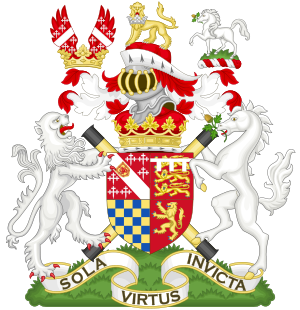 |
|
Titles
| Title | Grantee | Created | Extinct | Notes |
|---|---|---|---|---|
| 28 June 1483 | Premier duke of England | |||
| Premier earl of England; subsidiary to the Duke of Norfolk since 1660 | ||||
| Subsidiary to the Duke of Norfolk since 1660 | ||||
| Lord William Howard | 1554 | |||
| Charles Howard, 2nd Baron Howard of Effingham | 1596 | 1681 | ||
| Admiral Lord Thomas Howard | 1597 | Created by writ of summons. Has passed through many families. | ||
| 1603 | ||||
| Lord Thomas Howard | 1626 | |||
| Edward Howard | 12 April 1628 | 29 April 1715 | ||
| Lord William Howard | 1640 | |||
| 1640 | 1762 | |||
| Mary Howard, 1st Baroness Stafford | 1688 | |||
| Thomas Howard, 14th/21st Earl of Arundel | 1644 | |||
| Charles Howard | 20 April 1661 | 1st Earl also created Viscount Howard by Oliver Cromwell, which passed into oblivion upon the Restoration. | ||
| Henry Howard | 30 January 1706 | 8 February 1722 | Held with the Earl of Suffolk from 1709 to 1722 | |
| Francis Howard, 7th Baron Howard of Effingham | 8 December 1731 | 11 December 1816 | ||
| General Kenneth Alexander Howard, 11th Baron Howard of Effingham | 27 January 1837 | |||
| Lord Edward George Fitzalan Howard | 26 November 1869 | Subsidiary to Dukedom of Norfolk since 1975. | ||
| Admiral The Honourable Edward Granville George Howard | 1 January 1874 | 8 October 1880 | ||
| Lord Edmund Bernard Talbot née FitzAlan-Howard | 28 April 1921 | 17 May 1962 | ||
| Esmé William Howard | 10 July 1930 | |||
| Major George Anthony Geoffrey Howard, JP | 1 July 1983 | 27 November 1984 | Life Peerage | |
| Greville Patrick Charles Howard | 4 June 2004 | Life Peerage |


